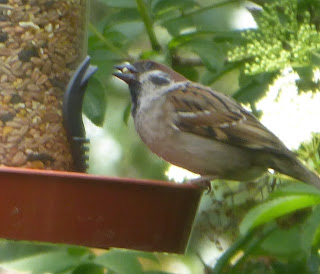This wasn't a dedicated nature holiday, the main aims being cultural and relaxation in various forms. Some of the sightings I did make were annoyingly fleeting, making identification tricky.
One day though, I visited the University Botanical Gardens with its impressive array of gardens and trees. On the way from the nearest bus stop there were a couple of butterflies and an elusive black redstart.
Once there, I had my first sighting of a common blue in an area of rewilding and a spectacular stripey bug on an exotic plant.
 | | Common Blue |
|  | | Minstrel Bug |
|
Apparently it's an Italian Striped Bug or Minstrel Bug. Also fleetingly sighted for the first time this year were common darter and marbled white. On some steps a nomad bee was so active that I couldn't get a picture of it. This was a pity as all the bees I saw afterwards were honey bees or obvious forms of bumblebee.
On the way to a bike hire place, I had a couple of forays along the River Ammer, where there were a few trout rising and this slightly puzzling duck with a blue sheen on its head feathers.
There is a thing called the Blue-headed Mallard in America and the beak certainly looks mallardy but on balance I think this is probably some sort of hybrid.
 |
| Mallard Hybrid? |
Another teaser occurred during my one bike ride on a decrepit city bike. At the edge of a farm field I happened on a couple of large pipits of a long thin body shape and a palish chest marking. Of course, they moved on soon after I stopped. It was hard to make them out properly against the light but I reckoned that tawny pipit was likely.
A couple of days later, I caught sight of a butterfly flying along the hedgerow that had all the signs of being a brown hairstreak, my first ever, but of course it did not land. Later on I was amused to find a pair of Egyptian Geese casually surveilling the punts and sunbathers by the Neckar.
 |
| Egyptian Goose |
I ended up in a Biergarten by the river, feeding fragments of bread to a decent sized carp - almost as satisfying as catching one.
The last day of my holiday was a dedicated nature outing. I took a bus to Bebenhausen, which offers a number of walks on the southern tip of the Naturpark Schönbuch.
The first thing I saw, before even leaving the village was a small white butterfly - except something about it struck me as unusual. I think in fact it was a Southern Small White. If so it was pretty much right on the Northern edge of its established range but I'm pretty confident about this one. The giveaway is that the black edging extends slightly down the outer edge of the upper forewing.
 |
| Southern Small White |
Although the forecast was for very hot weather, it took a while for the clouds to disperse. When they did, another white appeared by the side of the Fohlenweideweg - a fair number of wood whites, always nice to see as they do not occur in the North of Britain.
Wood White
Their weak, erratic flight means that wood white sites are very precious as the butterflies are unlikely to relocate over any distance.
Ironically the real fun butterflies started when I took a wrong turn and went down a wee overgrown lane. I was surprised to find that the dominant butterfly here was the pearly heath.
 |
| Pearly Heath |
I'd seen the pearly heath several times when I was
in Bulgaria but did not know it extends across mainland Europe.
Several expected items turned up including another common blue, and, looking smart, meadow brown and ringlet.
 | | Meadow Brown |
|  | | Common Blue |
|  | | Ringlet |
|
I also spent some time confirming that the small skipper I saw was a small skipper, as Essex or Lulworth Skipper were also feasible. Anyway, it is.
 |
| Small Skipper |
More troublesome was a very small and worn female blue that kept fluttering around the path track without settling more than briefly. My feeling is that it may be a Silver Studded Blue but without better images, it's hard to be sure,
 |
| Silver Studded Blue? |
Then there was the one that completely defeated me, as I couldn't find anything that resembled this rather smart-looking black moth. Or maybe it's not even a moth at all?
 |
| Unidentified Flying Object |
It almost looks like the translucent wing tips are reflecting the treetops above.
Last of all. the most joyful appearance went completely undocumented when a massive purple emperor came down and flattered briefly in front of my midriff. I waited around for half an hour for it to return but there was no further sign.


















































